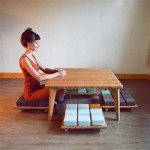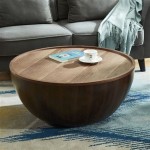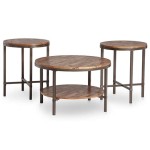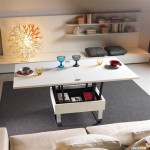Can a Coffee Table Be Higher Than the Couch? Exploring Coffee Table Height Considerations
The relationship between a coffee table and a couch is crucial for both functionality and aesthetics within a living room. The height differential between these two pieces of furniture significantly impacts how the space is used and perceived. While a lower coffee table is often considered the norm, the question of whether a coffee table can be higher than the couch warrants careful consideration, exploring various factors that influence the decision.
Traditionally, coffee tables were designed to be lower than the seating area of a couch, typically around the same height as the seat cushion or slightly lower. This design choice allows for easy access to items on the table, such as drinks, books, or remote controls, without requiring occupants to reach upwards uncomfortably. The lower profile also contributes to a more open and visually spacious feel in the room, as it doesn't obstruct the view across the seating area.
However, strict adherence to this traditional guideline might not always be the best approach. Contemporary design trends and evolving lifestyle preferences have broadened the acceptable range for coffee table heights. Considering the specific couch design, room dimensions, and intended use of the coffee table, a higher table may, in certain situations, be a more practical and aesthetically pleasing choice.
Understanding Ergonomics and Reach
Ergonomics play a vital role in determining the appropriate height of a coffee table relative to the couch. The primary function of a coffee table is to provide a surface for resting items and facilitating activities while seated. When the table is significantly lower than the couch seat, it can require users to lean forward excessively, potentially leading to back strain or discomfort over prolonged periods. A slightly higher table, closer to the armrest height of the couch, can minimize this strain and promote a more comfortable and natural posture.
Specifically, the ease of reaching for items on the table should be a primary consideration. If the coffee table is frequently used for dining or working, a higher surface may be preferable. Imagine a scenario where individuals are eating snacks or using laptops on the couch. A lower table would necessitate bending over, which can quickly become tiring. A higher table allows for a more upright position, creating a more ergonomic and user-friendly experience. The ideal height will be dependent on the average height of the users and the typical activities performed while seated.
Moreover, the type of couch itself influences the optimal coffee table height. A low-slung, modern couch will naturally pair better with a lower coffee table. Conversely, a couch with a higher seat and prominent armrests may benefit from a slightly taller coffee table. The goal is to create a harmonious balance where the coffee table complements the couch's design and provides convenient access without causing undue strain.
Considering Visual Balance and Room Aesthetics
Beyond ergonomics, the visual impact of the coffee table's height on the overall room design should be thoughtfully evaluated. The height of the coffee table contributes significantly to the visual balance and flow of the living space. A coffee table that is disproportionately low can appear dwarfed by the surrounding furniture, while one that is excessively high can feel imposing and disrupt the visual harmony.
In smaller living rooms, a lower coffee table can help to create a sense of spaciousness by minimizing visual obstructions. Conversely, in larger rooms with high ceilings, a slightly taller coffee table can help to fill the vertical space and create a more grounded and balanced feel. The key is to ensure that the coffee table complements the scale of the room and the other furniture pieces, contributing to a cohesive and visually appealing aesthetic.
The style of the coffee table itself also plays a role in how its height is perceived. A sleek, minimalist coffee table may look more streamlined at a slightly lower height, while a more substantial, decorative table might benefit from a slightly taller stature to showcase its design features. The material and finish of the table can also influence the perceived height. A glass-topped coffee table, for example, may appear less visually dominant than a solid wood table, allowing for greater flexibility in height selection.
Evaluating Functionality and Intended Use
The primary function and intended use of the coffee table should be a major determinant of its height relative to the couch. A coffee table used primarily for decorative purposes may not require the same considerations as one used for functional tasks such as dining, working, or playing games. The frequency of use and the types of activities performed on the table will significantly influence the optimal height selection.
If the coffee table is regularly used as a dining surface, a height closer to that of a dining table may be preferable. This will allow users to sit comfortably on the couch while eating without having to hunch over excessively. Similarly, if the table is often used for working on a laptop or playing board games, a higher surface can provide a more ergonomic and comfortable work area.
Furthermore, storage needs can also influence the height selection. Coffee tables with built-in storage compartments, such as drawers or shelves, may need to be slightly taller to accommodate the storage space. This added height can also provide a more substantial and visually appealing presence in the room. The intended use must be carefully considered to ensure that the chosen coffee table height effectively meets the needs of the users and enhances the functionality of the living space.
In conclusion, the question of whether a coffee table can be higher than the couch is not a simple yes or no answer. The optimal height is highly dependent on a variety of factors, including ergonomics, aesthetics, and intended use. By carefully considering these factors, individuals can make informed decisions about coffee table height and create a living space that is both functional and visually appealing.

Can A Coffee Table Be Higher Than Couch Big Cool Tables Sofa

Should I Have A Coffee Table Higher Than Sofa Wehomz
Four Tips For Choosing The Right Coffee Table Post
If I Have Really Low Couches Is It Ok To Get A Coffee Table That Higher Than The Seat Part Of Our Or Design No Quora

Can A Coffee Table Be Taller Than The Sofa Myfurnitureplan Com
:strip_icc()/cdn.cliqueinc.com__cache__posts__268833__how-to-choose-a-coffee-table-268833-1538077811019-image.700x0c-7a56fb07e0084a48b51032071b7fa87b.jpg?strip=all)
Don T Make This Living Room Coffee Table Mistake

Can A Coffee Table Be Higher Than Couch
:strip_icc()/cdn.cliqueinc.com__cache__posts__268833__how-to-choose-a-coffee-table-268833-1538077811556-image.700x0c-dd1536e2dae74b9199b81820901a5083.jpg?strip=all)
Don T Make This Living Room Coffee Table Mistake

Cote De Coffee Tables 101

How Tall Should End Tables Be Higher Than The Couch
Related Posts








